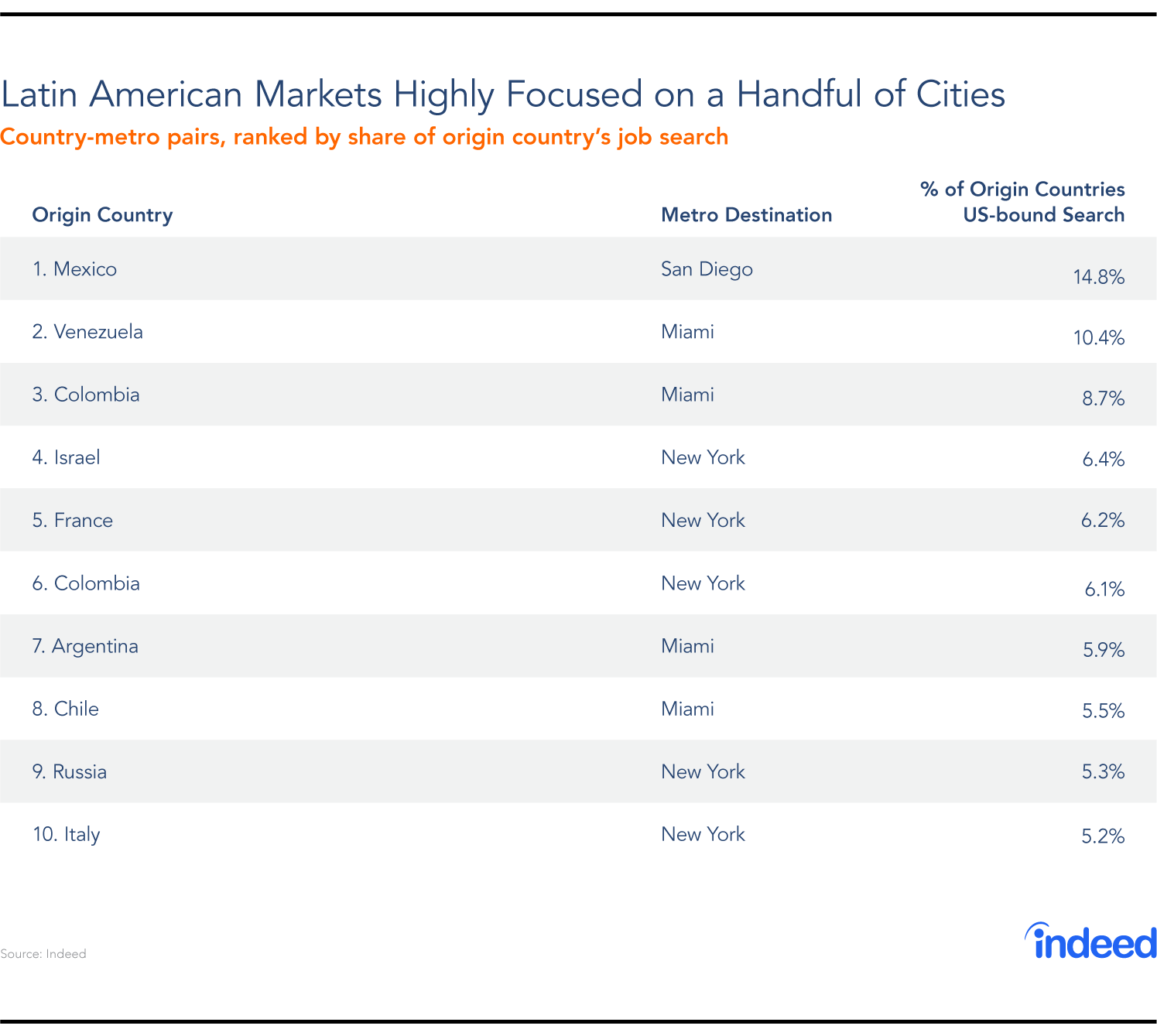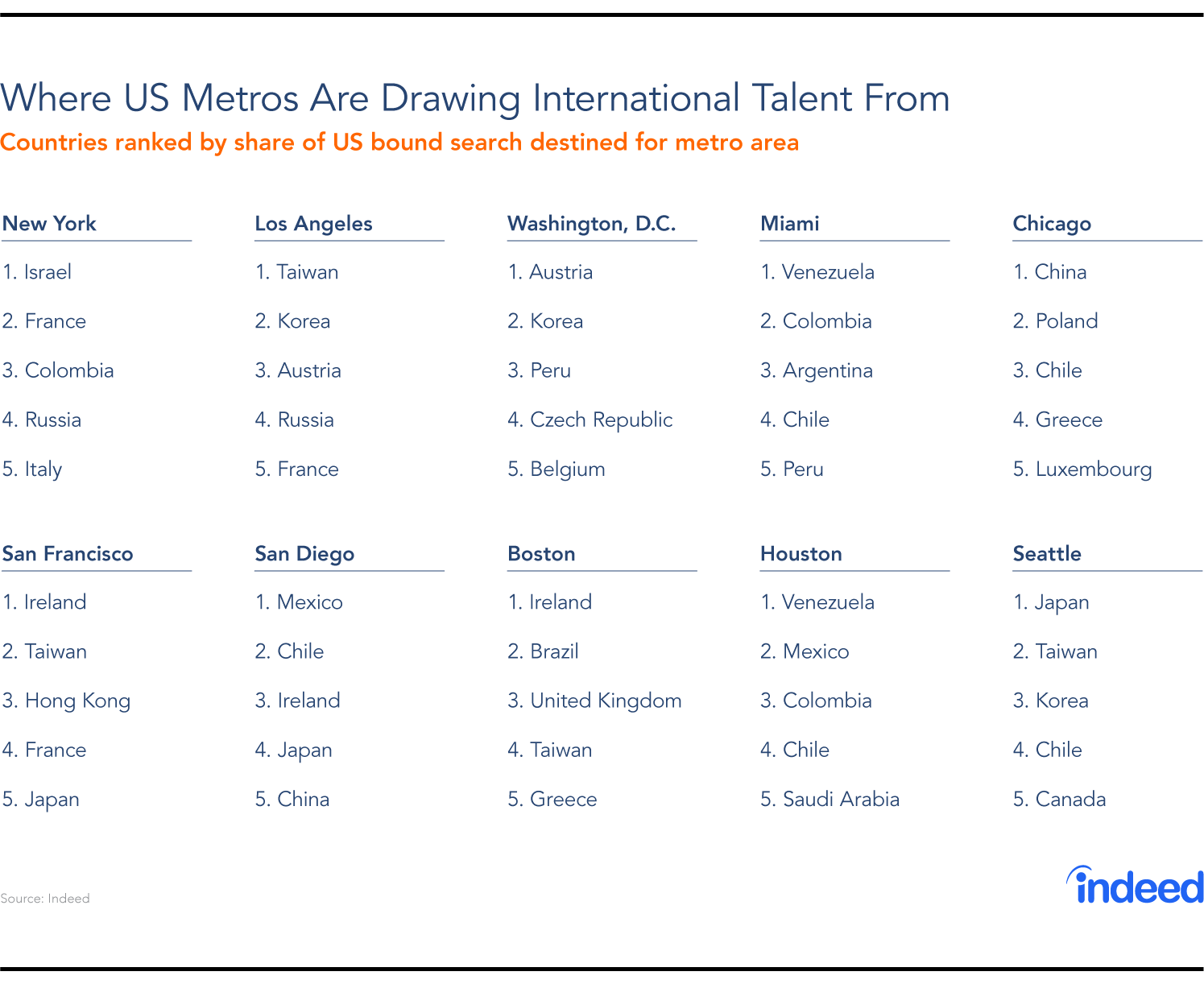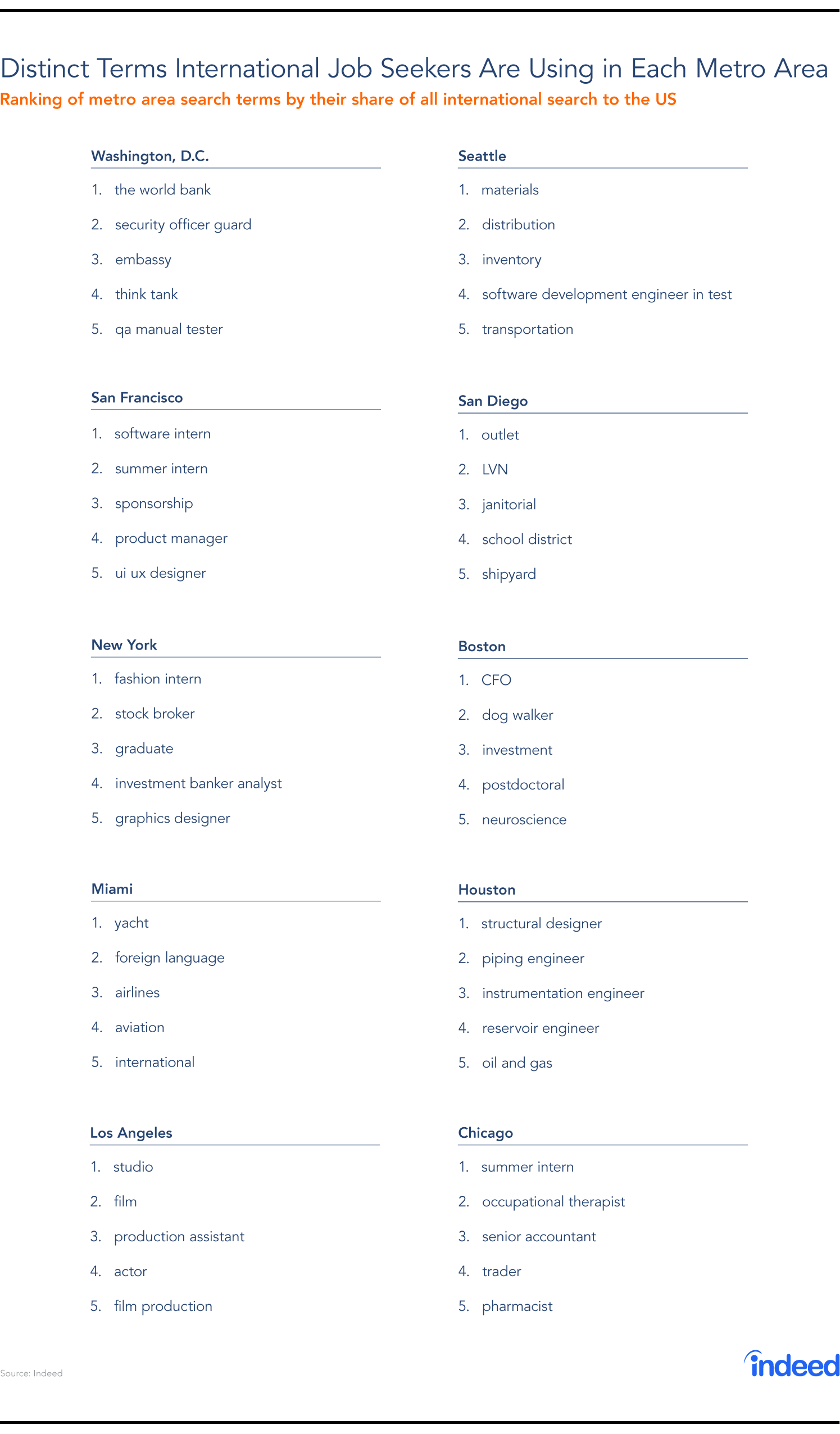Over the past year, international migration to the US has become a major controversy in political discourse and — correspondingly — the news cycle. Sometimes lost in all the heated discussion is a simple truth: That international migration to the US is by no means homogenous. Migrants from all over the world with varying career interests search for work in different areas of the US — and therefore impact US metro areas in disparate ways.
If policymakers and employers are to truly understand how migration can impact the labor market then it’s vital for them to grasp how a potential international labor pool can vary significantly from metro area to metro area. Indeed’s job search data can help illuminate some of these patterns in an international job search to the US, and also answer some specific questions, such as: Where exactly are these migrants coming from? Where are they most interested in working? And what type of work are they searching for in these different and diverse locations?
To answer these questions, we analyzed job searches that originated from Indeed sites in 52 countries across the globe and were directed to the 50 most populated metro areas in the United States between August 2016 through January 2017. Additionally, we also looked at the job search queries themselves to see what exactly these international job seekers are looking for in a particular metro area that they are not searching for as often elsewhere. Let’s take a look at what we found.
Mexico Dominates Search to San Diego, While Venezuela Leads for Miami
With Indeed’s job search data, we are able to determine which potential labor market flows are the strongest. Below is a list of the country-to-metro search pairs with the highest share of a country’s international job search destined to a particular metro area.

At the top of the list is the Mexico-to-San Diego job search flow, in which San Diego accounts for nearly 15% of Mexico’s job search to the US.
Outside of San Diego however, the list is dominated by Miami and New York. These are two metro areas which have strong ties to several markets, but for rather different reasons. While Miami has very strong ties to several Latin American markets (see below for more details), New York has a much broader appeal, attracting a high amount of interest from markets all over the world.
In fact, as would be expected due to its sheer size, New York is the biggest overall draw for US-bound international job seekers as measured by raw volume. When considering our measure outlined above, for five countries New York accounts for at least 5% US-bound job search — a feat replicated by no other US metro area.
Top Ten US Metros for International Job Search

Of all countries searching in New York, Israel is the market sending the highest share of its overall US-bound job search — about 6.4% overall — to the Big Apple. After Israeli job seekers, those from France and Colombia are the ones most interested in working in New York.
One result that may seem counterintuitive is that Mexico is at the top of the list for San Diego but does not appear in the top five at all for Los Angeles, where the population of Mexican- origin accounts for approximately 35% of the total population¹.
Keep in mind that this measure of job search traffic shows the level of interest a country is sending to a metro area, relative only to that country’s search to the US. What we find is that job seekers from Mexico are much more interested in San Diego, which accounts for nearly 15% of Mexico-to-US job search, than they are in Los Angeles, which accounts for only about 2.5% of the same figure.
This could be attributable to proximity, as San Diego is closer to Mexico than Los Angeles, or the possibility that Mexican job seekers are much more attracted to the types of jobs available in San Diego than they are to those in Los Angeles.
Irish Job-seekers Still Focused on Boston, Demonstrating Strength of Historical Ties
From the table above we can see that historical migration trends and geographical factors help determine where international job seekers look for work. International job seekers search patterns tend to have strong ties to metro areas where members of their native country have already established roots, otherwise known as ‘chain migration’.
This is perhaps best exemplified by the lists of countries sending the highest share of their US-bound job searches to Boston and Miami. Historical ties to Boston are still in play for Irish job seekers looking to relocate to the US, as Boston accounts for 1.9% of Ireland’s job search traffic coming across the pond.
As for Miami, here the Hispanic population accounts for about 43% of the total. Meanwhile, the five countries with the highest share of their US-bound job search destined for Miami are all Spanish-speaking, and their interest in the seaside metro area is rather strong. In fact, over 10% of all Venezuelan and 8.7% of all Colombian US-bound job searches are destined for Miami.
Proximity to Home Counts for International Jobseekers
Geography also plays a part in where international job seekers prefer to search in the US.
European markets, and others to the east, make up the majority of the top countries for Northeastern cities such as New York, Boston, and Washington DC. Job seekers from Asian markets are most interested in making the shortest possible trip over the Pacific, showing significant interest in west coast destinations.
For example, Taiwan appears in the top three for Los Angeles, Seattle, and San Francisco, while metro areas near the southern border, such as Houston and San Diego, are most attractive to job seekers from countries in the lower hemisphere, such as Mexico, Colombia and Venezuela.
What Do International Job seekers Want to Do in the US?
We know through overall search traffic which countries are most interested in the metro areas with the most international appeal, but taking the analysis of search traffic one step further can give insight into just what type of work these international job seekers are searching for in each metro area.
In the table below we have a list of job search terms, including job titles, skills and areas of interest, ranked by that metro area’s share of all US-bound international job searches for that particular term. In these rankings, there are patterns of common search terms based on the industries and jobs that these metro areas are typically most known for.

For example, at the top of the New York’s list are two terms related to perhaps their most well-known industries. Searches for ‘fashion intern’ in New York account for half of all ‘fashion intern’ searches coming to the US from abroad, while the same measure for ‘stock broker’ is about 43%.
San Francisco lives up to its reputation as a tech hub, with many of its search terms related to tech roles. Seattle, another city lauded for its tech prominence, features some tech searches but also many more related to its other industries. As for Washington DC, the city attracts a lot of interest from job seekers interested in public service jobs — with searches for positions directly with the government and ancillary organizations topping the list.
Houston retains its status as the place to be for oil, with every single one of its most distinct search terms having some association with the oil industry. Similarly, the majority of Los Angeles’ most distinct searches revolve around the film industry.
Capitalizing on International Job Search
This research sheds light on the US metro areas that are most appealing to job seekers from Indeed’s international markets. What’s clear is that most metro areas are attracting interest from a diverse group of countries.
Moreover, while job seekers are most attracted to metro areas that afford them the greatest amount of opportunity, cultural and geographic factors carry influence in job seeker preferences as well. Those metro areas that continue to capitalize on these inflows, and their employers, will benefit from greatly diverse and growing pool of workers.
Notes:
- Pew Research Center, http://www.pewhispanic.org/interactives/hispanic-population-in-select-u-s-metropolitan-areas/, (September 6, 2016)
Methodology
This research is based on a six month sample, August 2016 through January 2017, of aggregated and anonymized job search data from Indeed sites in 53 countries across the globe. The focus of this analysis is job search traffic originating in these international markets and directed to the 50 most populated metro areas in the United States. To identify what distinct terms international job seekers are searching for in each metro area we first pulled the top 5000 search terms most frequently used by international job seekers looking for jobs in the US. For each search term, we then calculated the share of that US-bound search that is destined for each of our metro areas and ranked the search terms to each metro area by its share of all US-bound search.

